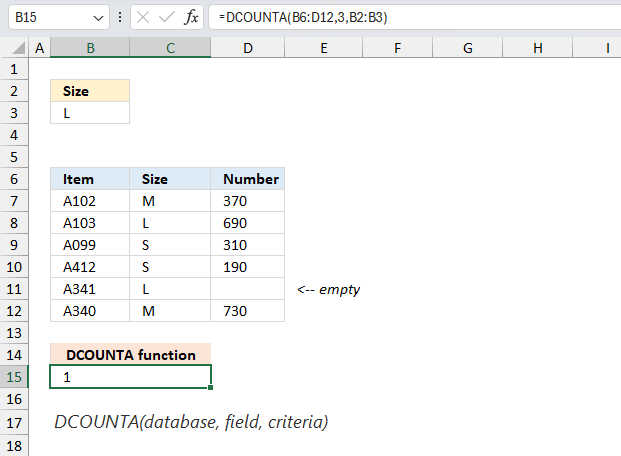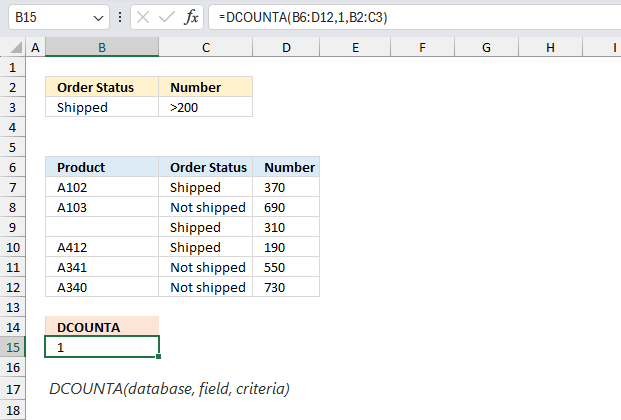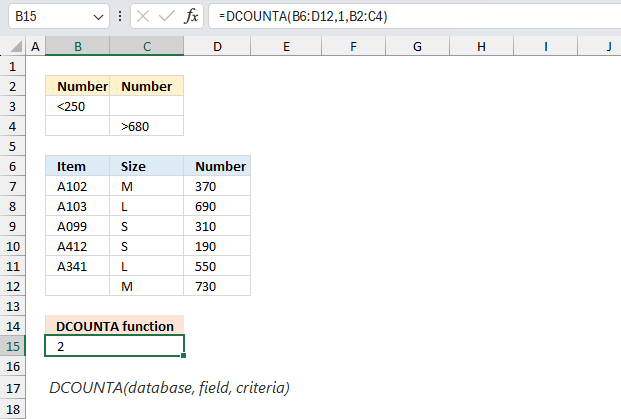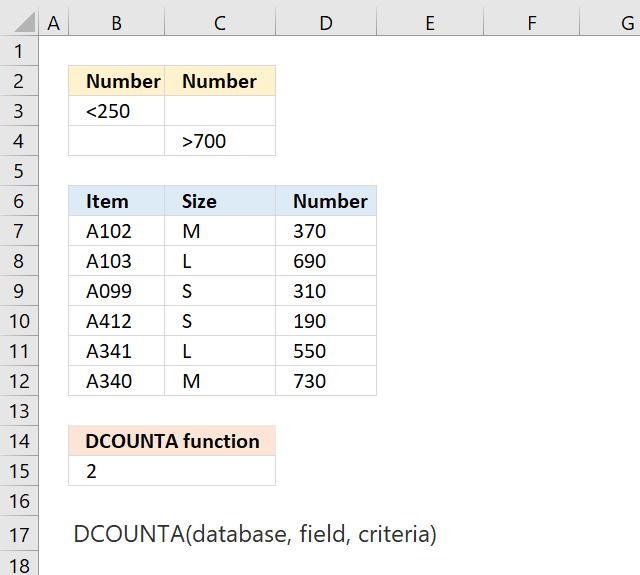How to use the DCOUNTA function
What is the DCOUNTA function?
The DCOUNTA function counts nonempty cells in a column you specify, in a database where records also meet a condition or criteria.
Table of Contents
1. Introduction
What is DCOUNTA an abbreviation of?
DCOUNTA is an abbreviation of Database Counta. COUNTA probably means count all, in other words, it counts all cells in a given range that contains data.
What is a database in this context?
Excel defines a database as a list of related data in which rows of related information are records, and columns of data are fields. The first row of the list contains labels for each column.
Where can you place the criteria range?
You can place your criteria range wherever you want on your worksheet, however, it is not recommended below the list/database. The function needs a blank row below the list to work properly.
What criteria characters are allowed?
Allowed criteria range characters are less than and greater than signs <>, use them to specify a criteria range. Also, asterisks * can be used to match partial strings.
Does the DCOUNTA function ignore blank cells?
Yes, blank cells are ignored.
Does the DCOUNTA function ignore error values?
No, the DMAX function does not ignores error values. A cell containing an error value is counted.
What is the difference between the DCOUNTA function and the COUNTA function?
The DCOUNTA function counts non empty cells based on a condition or criteria in a list/database whereas the COUNTA function counts non empty cells without using a condition/criteria.
How to include the entire database in the calculation?
To include the entire list/database enter a blank line below the criteria range column labels. In other words, don't specify any criteria.
When is the count of non-empty cells useful?
- Data Validation: Working with large datasets it's essential to ensure that all required fields are filled in. It allows you to identify any missing data or incomplete entries.
- Conditional Calculations: Perform a calculation only if a certain number of cells in a range are filled in, or skip a calculation if a particular column is empty.
- Inventory Management: Count the number of items in stock or the number of products with non-empty quantities. This information can be used for stock monitoring, reordering, or generating reports.
- Survey Analysis: Counting the number of respondents who provided an answer to a particular question. This can help identify questions with low response rates or highlight popular choices in multiple-choice questions.
- Project Planning: Count the number of tasks or activities that have been assigned resources or start/end dates. This information can be valuable for tracking project progress, resource allocation, or identifying potential bottlenecks.
2. Syntax and Arguments
DCOUNT(database, field, criteria)
| database | Required. The cell reference to a list or database. |
| field | Optional. The field argument lets you choose which column to use. You can use the column name enclosed with double quotation marks or the corresponding column number. If not entered DCOUNTA counts all records in the database that match the condition. |
| criteria | Required. A cell reference to the criteria range. The criteria range needs to have column labels and a at least one condition below the column label. |
3. Example 1

In an inventory database, you want to count the number of products where the "Size" category column is equal to "L", do not count empty cells in column "Number". How can you use the DCOUNTA function to get this count?
The data in cell range B6:D12, note that cell D11 is empty.
| Item | Size | Number |
| A102 | M | 370 |
| A103 | L | 690 |
| A099 | S | 310 |
| A412 | S | 190 |
| A341 | L | |
| A340 | M | 730 |
The condition is in cell range B2:B3:
| Size |
| L |
The arguments are:
database = B6:D12
field = 3
criteria = B2:B3
Formula in cell B15:
The formula finds one cell that meets the condition "L" and the corresponding cell in column "Number" is non-empty.
4. Example 2

In a sales database, you want to count the number of orders where the "Product Category" column is not blank, the "Order Status" column is set to "Shipped" and the "Number" column is set to numbers larger than 200. How can you use the DCOUNTA function to get this count?
This example demonstrates AND logic, two different conditions must match on the same row.
The data in cell range B6:D12, note that cell B9 is empty.
| Product | Order Status | Number |
| A102 | Shipped | 370 |
| A103 | Not shipped | 690 |
| Shipped | 310 | |
| A412 | Shipped | 190 |
| A341 | Not shipped | 550 |
| A340 | Not shipped | 730 |
The criteria are in cell range B2:C3:
| Order Status | Number |
| Shipped | >200 |
The arguments are:
database = B6:D12
field = 3
criteria = B2:C3
Formula in cell B15:
The formula matches the condition "Shipped" in cells C7:C9 and C10, the condition above 200 matches cells D7:D12 except D10. If all conditions are taken into consideration cells B7 and B9 are evaluated, however, cell B9 is empty. The count is 1.
5. Example 3

This example demonstrates OR logic, two different conditions must match on the same row.
You want to count the number of products, in a price database, where the "Item" column is not blank, the "Number" column is smaller than 250 and larger than 680. How can you use the DCOUNTA function to get this count?
The data in cell range B6:D12, note that cell D12 is empty.
| Item | Size | Number |
| A102 | M | 370 |
| A103 | L | 690 |
| A099 | S | 310 |
| A412 | S | 190 |
| A341 | L | 550 |
| M | 730 |
The criteria are in cell range B2:C4. The criteria are on a row each, this makes the formula perform or logic instead of AND logic.
| Number | Number |
| <250 | |
| >680 |
The arguments are:
database = B6:D12
field = 3
criteria = B2:C4
Formula in cell B15:
The formula counts records where the number is above 700 or below 250. Also, the cell must not be blank in column 1 (Item). Only row 8 and row 10 match the criteria, the function returns 2 in cell B15.
6. Function not working

The DCOUNTA function returns a #VALUE! error if the field argument is out of range.
6.1 Troubleshooting the error value

When you encounter an error value in a cell a warning symbol appears, displayed in the image above. Press with mouse on it to see a pop-up menu that lets you get more information about the error.
- The first line describes the error if you press with left mouse button on it.
- The second line opens a pane that explains the error in greater detail.
- The third line takes you to the "Evaluate Formula" tool, a dialog box appears allowing you to examine the formula in greater detail.
- This line lets you ignore the error value meaning the warning icon disappears, however, the error is still in the cell.
- The fifth line lets you edit the formula in the Formula bar.
- The sixth line opens the Excel settings so you can adjust the Error Checking Options.
Here are a few of the most common Excel errors you may encounter.
#NULL error - This error occurs most often if you by mistake use a space character in a formula where it shouldn't be. Excel interprets a space character as an intersection operator. If the ranges don't intersect an #NULL error is returned. The #NULL! error occurs when a formula attempts to calculate the intersection of two ranges that do not actually intersect. This can happen when the wrong range operator is used in the formula, or when the intersection operator (represented by a space character) is used between two ranges that do not overlap. To fix this error double check that the ranges referenced in the formula that use the intersection operator actually have cells in common.
#SPILL error - The #SPILL! error occurs only in version Excel 365 and is caused by a dynamic array being to large, meaning there are cells below and/or to the right that are not empty. This prevents the dynamic array formula expanding into new empty cells.
#DIV/0 error - This error happens if you try to divide a number by 0 (zero) or a value that equates to zero which is not possible mathematically.
#VALUE error - The #VALUE error occurs when a formula has a value that is of the wrong data type. Such as text where a number is expected or when dates are evaluated as text.
#REF error - The #REF error happens when a cell reference is invalid. This can happen if a cell is deleted that is referenced by a formula.
#NAME error - The #NAME error happens if you misspelled a function or a named range.
#NUM error - The #NUM error shows up when you try to use invalid numeric values in formulas, like square root of a negative number.
#N/A error - The #N/A error happens when a value is not available for a formula or found in a given cell range, for example in the VLOOKUP or MATCH functions.
#GETTING_DATA error - The #GETTING_DATA error shows while external sources are loading, this can indicate a delay in fetching the data or that the external source is unavailable right now.
6.2 The formula returns an unexpected value

To understand why a formula returns an unexpected value we need to examine the calculations steps in detail. Luckily, Excel has a tool that is really handy in these situations. Here is how to troubleshoot a formula:
- Select the cell containing the formula you want to examine in detail.
- Go to tab “Formulas” on the ribbon.
- Press with left mouse button on "Evaluate Formula" button. A dialog box appears.
The formula appears in a white field inside the dialog box. Underlined expressions are calculations being processed in the next step. The italicized expression is the most recent result. The buttons at the bottom of the dialog box allows you to evaluate the formula in smaller calculations which you control. - Press with left mouse button on the "Evaluate" button located at the bottom of the dialog box to process the underlined expression.
- Repeat pressing the "Evaluate" button until you have seen all calculations step by step. This allows you to examine the formula in greater detail and hopefully find the culprit.
- Press "Close" button to dismiss the dialog box.

There is also another way to debug formulas using the function key F9. F9 is especially useful if you have a feeling that a specific part of the formula is the issue, this makes it faster than the "Evaluate Formula" tool since you don't need to go through all calculations to find the issue..
- Enter Edit mode: Double-press with left mouse button on the cell or press F2 to enter Edit mode for the formula.
- Select part of the formula: Highlight the specific part of the formula you want to evaluate. You can select and evaluate any part of the formula that could work as a standalone formula.
- Press F9: This will calculate and display the result of just that selected portion.
- Evaluate step-by-step: You can select and evaluate different parts of the formula to see intermediate results.
- Check for errors: This allows you to pinpoint which part of a complex formula may be causing an error.
The image above shows cell reference B2:B3 converted to hard-coded value using the F9 key, however, there is nothing wrong with these values. The DCOUNTA function requires a valid number in the second argument which is not the case in this example. We have found what is wrong with the formula.
Tips!
- View actual values: Selecting a cell reference and pressing F9 will show the actual values in those cells.
- Exit safely: Press Esc to exit Edit mode without changing the formula. Don't press Enter, as that would replace the formula part with the calculated value.
- Full recalculation: Pressing F9 outside of Edit mode will recalculate all formulas in the workbook.
Remember to be careful not to accidentally overwrite parts of your formula when using F9. Always exit with Esc rather than Enter to preserve the original formula. However, if you make a mistake overwriting the formula it is not the end of the world. You can “undo” the action by pressing keyboard shortcut keys CTRL + z or pressing the “Undo” button
6.3 Other errors
Floating-point arithmetic may give inaccurate results in Excel - Article
Floating-point errors are usually very small, often beyond the 15th decimal place, and in most cases don't affect calculations significantly.
Functions in 'Database' category
The DOUNTA function function is one of 11 functions in the 'Database' category.

How to comment
How to add a formula to your comment
<code>Insert your formula here.</code>
Convert less than and larger than signs
Use html character entities instead of less than and larger than signs.
< becomes < and > becomes >
How to add VBA code to your comment
[vb 1="vbnet" language=","]
Put your VBA code here.
[/vb]
How to add a picture to your comment:
Upload picture to postimage.org or imgur
Paste image link to your comment.
Contact Oscar
You can contact me through this contact form